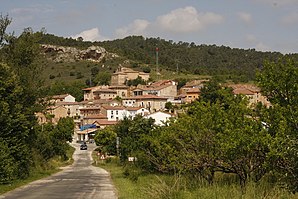Aguas Cándidas
| Aguas Cándidas parish | ||
|---|---|---|
 Aguas Cándidas - town view
|
||
| coat of arms | Map of Spain | |

|
|
|
| Basic data | ||
| Autonomous Community : |
|
|
| Province : | Burgos | |
| Comarca : | La Bureba | |
| Coordinates | 42 ° 43 ′ N , 3 ° 30 ′ W | |
| Height : | 730 msnm | |
| Area : | 17.95 km² | |
| Residents : | 56 (Jan. 1, 2019) | |
| Population density : | 3.12 inhabitants / km² | |
| Postal code : | 09593 | |
| Municipality number ( INE ): | 09006 | |
| administration | ||
| Website : | Aguas Cándidas | |
Aguas Cándidas is a place and a total of three hamlets (Aguas Cándidas, Quintanaopio and Río Quintanilla) existing northern Spanish rural municipality ( municipio ) with a total of only 56 inhabitants (at January 1, 2019) in the province of Burgos in the autonomous community of Castile and Leon .
Location and climate
The three hamlets of the municipality of Aguas Cándidas are located on the Río Vadillo in the Valle de las Caderechas at an altitude of about 730 m in the rainy landscape of La Bureba . The provincial capital Burgos is about 55 km (driving distance) to the southwest; the next larger city, Briviesca , is approx. 29 km to the southeast. The climate in winter is harsh, but in summer it is temperate and warm; Rain (approx. 750 mm / year) falls mainly in the winter half-year.
Population development
| year | 1857 | 1900 | 1950 | 2000 | 2017 |
| Residents | 428 | 4083 | 490 | 93 | 56 |
The mechanization of agriculture and the closure of smaller farms have led to a loss of jobs and thus to an exodus of people to the larger cities ( rural exodus ) since the 1950s .
economy
For centuries, the inhabitants of the community lived mainly from agriculture (agriculture, viticulture and small livestock farming) as a self-sufficient living ; only since the middle of the 20th century has it been produced for the national market. Tourism in the form of rental of holiday homes (casas rurales) has also played a certain role in the municipality's income since the 1960s.
history
The area was already known to the people of the Stone Age and antiquity as a hunting area; Celts from the Autrigone tribe settled here, but neither they nor the Romans or the Visigoths left any traces. In the 8th and early 9th centuries, the area was under Islamic influence, but the area was neither permanently settled nor defended due to the unusually harsh climate. At the end of the 9th century, the Castilian Count Diego Rodríguez Porcelos received from King Alfons III. of Asturias the order to repopulate ( repoblación ) the depopulated area. The first mention of the place name can be found in a document from 1133 from the monastery of San Salvador de Oña .
Attractions
- Aguas Cándidas
- The Gothic Iglesia de San Juan Bautísta is dedicated to John the Baptist ; it stands at the highest point of the place. The nave (nature) is rib-curved ; it contains several baroque altarpieces (retablos) .
- Quintanaopio
- The likewise Gothic Iglesia de Nuestra Señora de la Asunción in the hamlet of Quintanaopio , about 4 km to the north, is dedicated to the Assumption of Mary . The late Gothic keel arch portal protrudes slightly from the wall.
- Río Quintanilla
- The late Romanesque Ermita de San Emeterio y San Celedonio is a small, single-nave building made of precisely hewn stones with a three-part bell gable (espadaña) above the triumphal arch inside, which can be reached via an outside staircase . The apse is divided by two half-column models resting on pillars . The portal is rather simple.
- The Ermita de San Roque is badly damaged, the roof has collapsed.
- On the outskirts there is a squat tower from the 15th century, which probably belonged to a former castle (castillo) .
Web links
- Aguas Cándidas - Photos + Info (wikiburgos, Spanish)
- Quintanaopio - Photos + Info (wikiburgos, Spanish)
- Río Quintanilla - Photos + Info (wikiburgos, Spanish)
Individual evidence
- ↑ Cifras oficiales de población resultantes de la revisión del Padrón municipal a 1 de enero . Population statistics from the Instituto Nacional de Estadística (population update).
- ↑ Aguas Cándidas - population development
- ↑ Aguas Cándidas - History
- ↑ Río Quintanilla - Ermita
- ↑ Quintanaopio - Church etc.

